PHILADELPHIA, 9 September — Gamification with Kevin Werbach of the University of Pennsylvania’s Wharton Business School, Week 2!
The ways game designers approach their craft is also the way to tackle a gamification project. Seeing situations through the lens of game design is an essential skill in this area.
Class Notes — Part 3 — Game Thinking
3.1 Why Gamify
Understanding problems through the lens of game thinking.
example: Dodgeball – one of first successful smart phone apps – successful, got bought by Google, but had “chicken & egg” problem. If you don’t already have a lot of friends, why bother checking in on a blank map.
• Engagement Gap
• Limited Choices (check in or don’t – a little analytics) Games with meaningful choices increase popularity.
• No Progression – continued checkins don’t “unlock” anything extra
• DID have Social Interaction and status with our friends
• DID have opportunity to make the action a Habit
Dennis Crowley’s next app, Foursquare, implemented Gamification.
• Mayorships (Badges, eg “Super Mayor” (10 places at once)) > made it easy to announce to your friends on Twitter etc, when you become the mayor of a venue
• Badges – now checking in becomes very rich, complex & nuanced for users, also allows you to Level Up
Foursquare now has over 20 million users, 70 million in venture capital, valued at over 600 million.
Gamification addressed engagement gap, habit formation, etc — that’s the thought process for approaching problems through the lens of game design.
3.2 Think Like a Game Designer
The key skill in gamification!
Jesse Schell in his book says to Utter Five Words:
“I Am A Game Designer”
>> Game design is a state of mind – we’ve all done this before, it comes naturally to human beings. It’s a skill that we can cultivate. Resolve that you’re going to look at your problem as a game designer. Whatever your goal may be. Think about it as a game. What would you do?
• Different than being a game designer
(you’re not actually going to become a game designer! That’s a whole career!)
• Different than thinking like a gamer
You need to “pull back the curtain” and think about the components you need to put together to create that experience
YOUR PARTICIPANTS AS “PLAYERS”
subtly different than thinking of them as “customer” or “consumer” or “user” or “guest” or “student”
The relationship is between Designer & Player
• Players are the center of a game
• Players feel a sense of autonomy / control
• Players Play (sense of free motion within a set of constraints)
Goal – create that sense of play – for a specific purpose
1. Get your players playing – easy to get in
2. and keep them playing
3.3 Design Rules
The Player Journey
• Onboarding – how to get into game as quickly & easily as possibly
• Scaffolding – “training wheels” get past complexity that could get player stuck
• Pathways to mastery – real accomplishment
example: Plants vs. Zombies – GO play Level 1 – notice onboarding & scaffolding
• http://www.popcap.com/
hahaha > fun, easy & satisfaction!
• Guides
• Hilighting
• Feedback
• Limited Options
• Limited Monsters
• Impossible to fail
All without any kind of manual! 🙂
if you tried to explain it all – sound weird & complicated
but Onboarding & Scaffolding make it easy
challenge down the road – keep it interesting
2nd Rule: BALANCE – not too easy, not too hard
a lot of game design is about ensuring that the game is constantly In Balance – tricky! – real people – never know what they’re gonna do – lots of testing!
Monopoly – challenge is keep property prices in balance so it can still be fun for all the players.
Pass GO, get $200 – why? Balance! Game has to keep the economy in balance. Too much initial money : inflation. Not enough continuing funds: recession.
Gamification >> Balance – not too hard / easy
3rd Design Rule: Create an Experience
example: Turntable.FM – not just listening to music, but “in a club” – involved not just in sitting and listening to music in your home, but AN EXPERIENCE. Not just clicking on iTunes tracks. Game like experience around picking music and listening to it.
3.4 Tapping the Emotions
What Makes Games Engaging? >>> FUN!!!
Mary Poppins: Work can be Fun
What Things are Fun?
• Winning
• Problem-solving
• Exploring
• Chillin’
• Teamwork (we’re hard wired as a species to enjoy collaborating with others)
• Recognition
• Triumphing
• Collecting (assemble a bunch of things)
• Surprise (unexpected, brain releases dopamine)
• Imagination, daydreaming
• Sharing – being altruistic is fun
• Role Playing – RPG to Imagining yourself in someone else’s shoes
• Customization
• Goofing off
For a game, business process, or some objective – how would use these different kinds of fun to engage peeps in the activity?
3.5 Anatomy of Fun
Nicole Lazzaro’s 4 Keys – what in games actually produces fun?
1. Easy Fun – blowing off steam, chillin, hanging out with friends, not taxing, casual, lite
2. Hard Fun – challenges, problem solving, overcoming obstacles
3. People Fun – interacting with others, working together on a team, socializing
4. Serious Fun – doing things that are meaningful: good for planet, community, yourself, accomplish objective
Marc Leblanc’s 8 Kinds of Fun
Sensation, Fantasy, Narrative, Challenge, Fellowship, Discovery, Experession, Submission
Raph Koster – book – A Theory of Fun for Game Design < good!
Takeaways on Fun
1. Fun must be DESIGNED!
2. Fun can be Challenging! – fun isn't always easy, can be hard, challenging, serious
3. Appeal to different kinds of fun
3.6 Finding the Fun
You can find fun in unexpected places.
VW campaign, “The Fun Theory” (The Speed Camera Lottery – non-speeders entered in lottery)
Look at the Piano Stairs — HAHAHA Ravanel’s Video!! 🙂
The World’s Deepest Trash Can — sensors & sound
• http://thefuntheory.com
In a way, Volkswagen’s “Fun Theory” is kind of Jessee Schell meets Jane McGonigal for me. It IS a lot of inspiring fun. Bravo! But it also expresses the hand of the central planner, some authority that knows best how we should live our lives, and uses this powerful technology to shape us into that behavior, into that sort of citizen. Certainly recycling can’t be bad. Certainly saving lives can’t be bad. Yet by ceding individual choice and responsibility to the “Government Game Design Department”…
ex: LinkedIn profiles – more full profiles with more details makes better networking and more likely to upgrade to paid services and more data for LinkedIn. No. They didn’t create a profile game. Just a “Profile Completeness Thermometer” — is that a game? Not really… but it’s a little bit fun… just enough to encourage people in meaningful ways.
When LinkedIn added this progress bar, profile completeness went up by 20%
What does it do?
• Feedback – immediate, real time feedback about performance
• Progression
• Completion – we like completion, neatness – draws us along subtly and imperceptibly
Very simple, yet drove real results – doesn’t always have to be massive fun, immersion
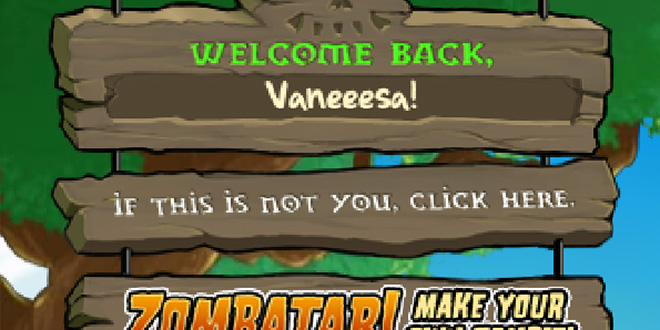
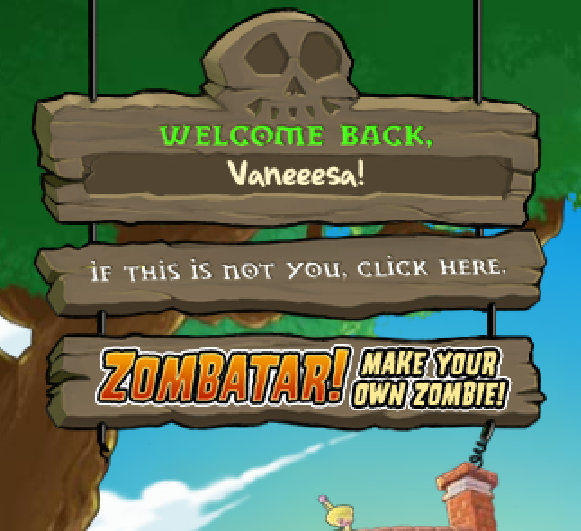
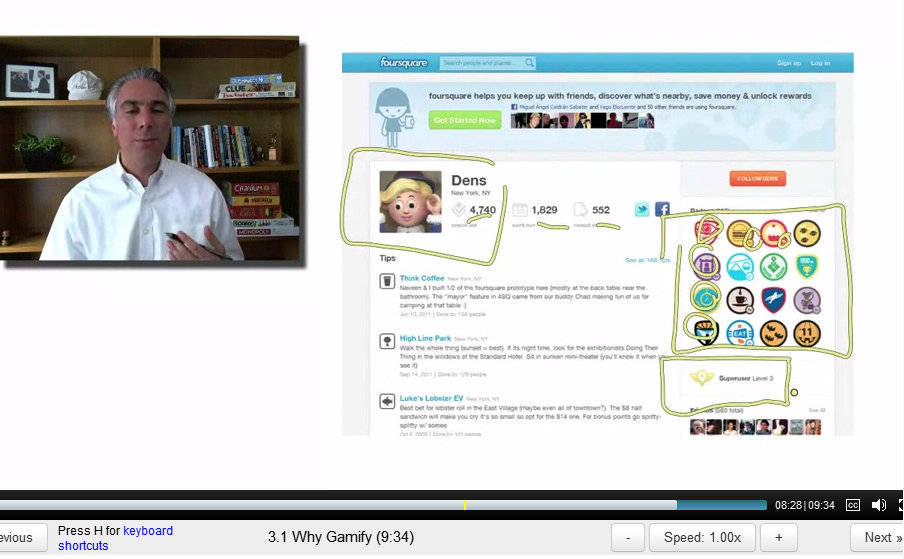
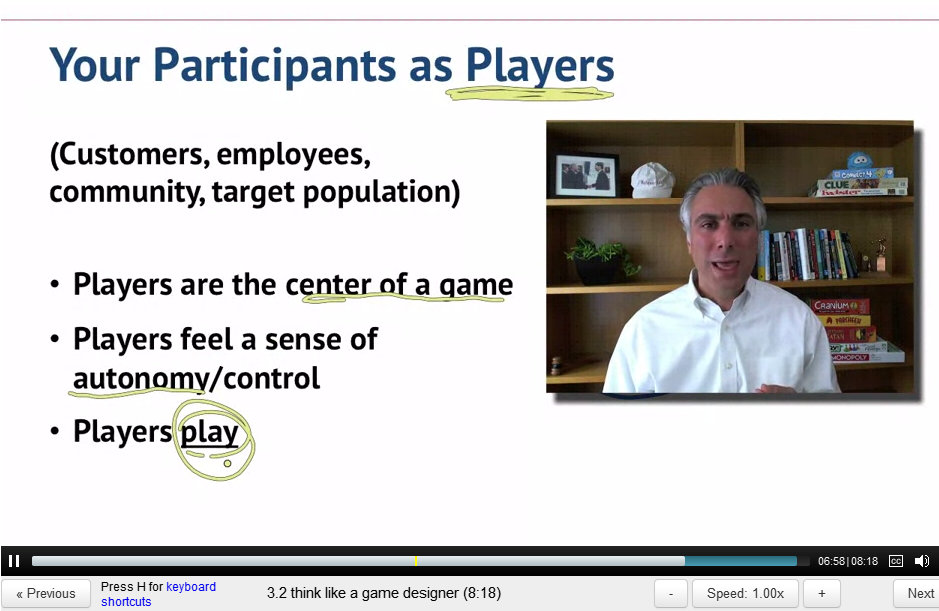
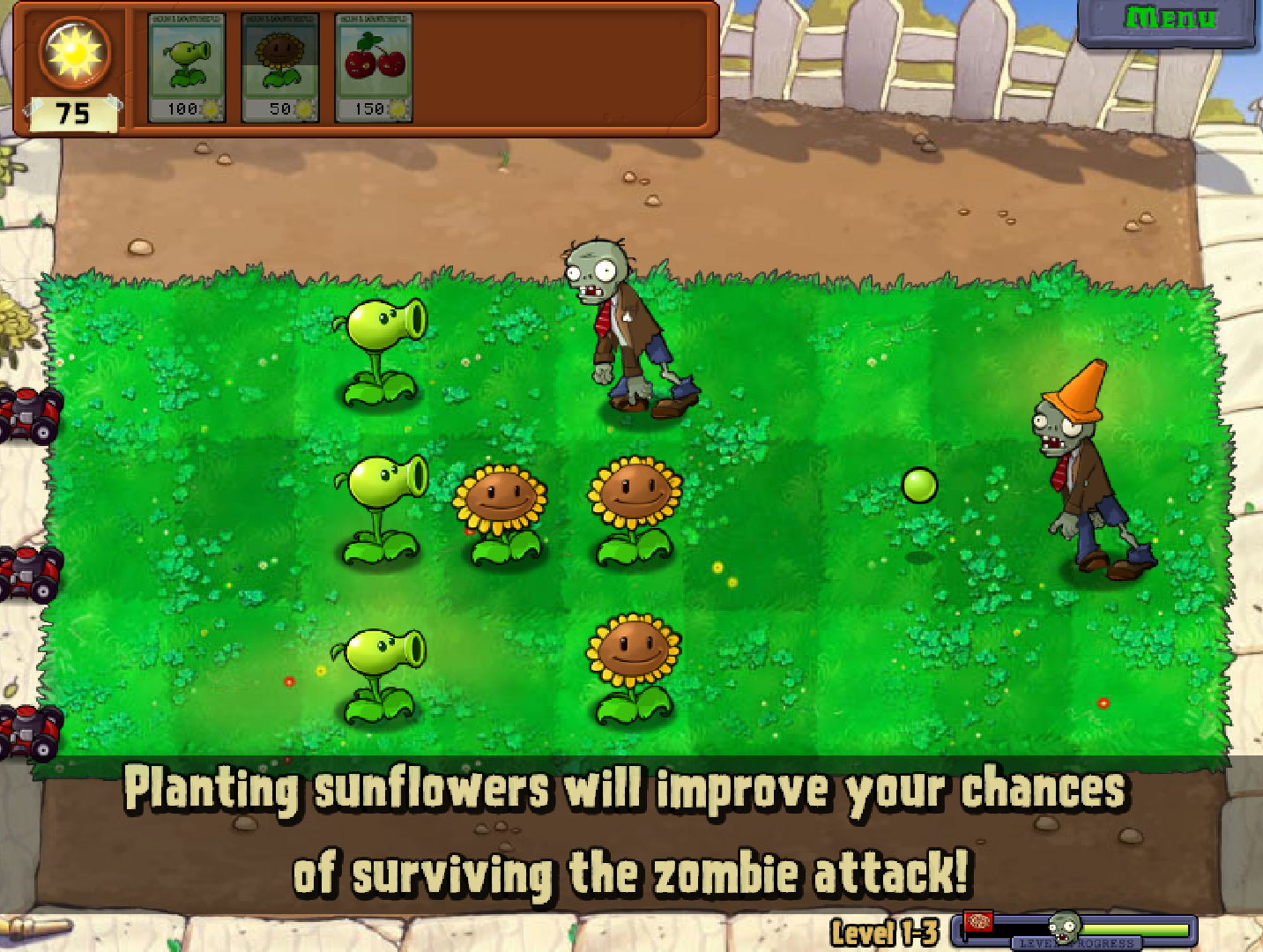

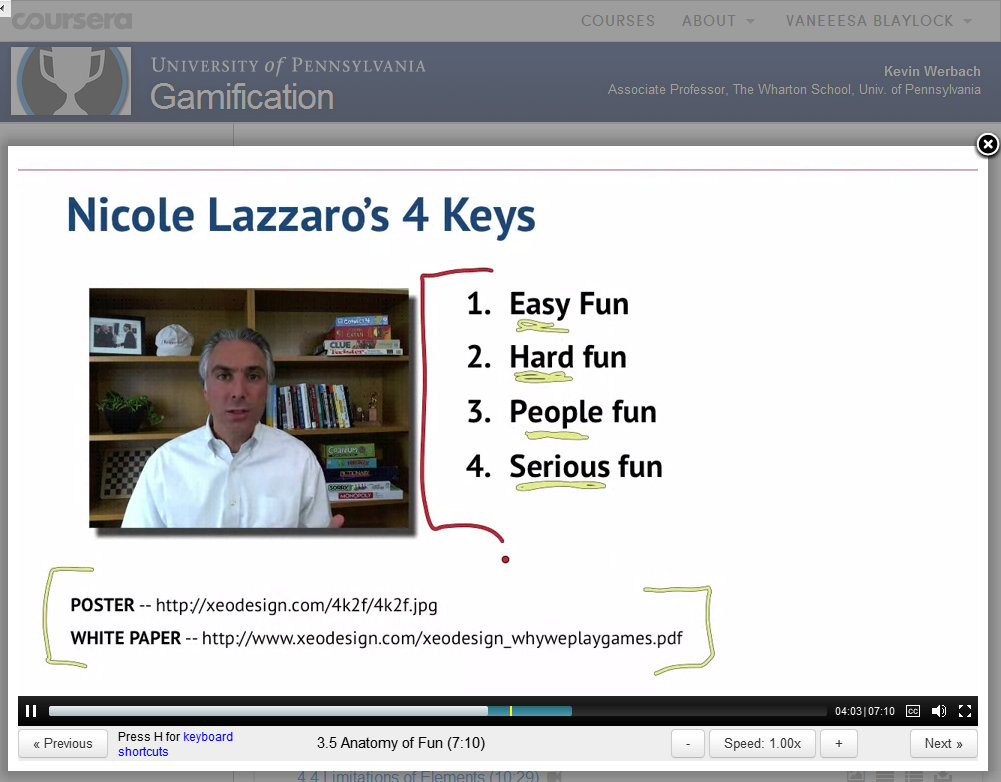
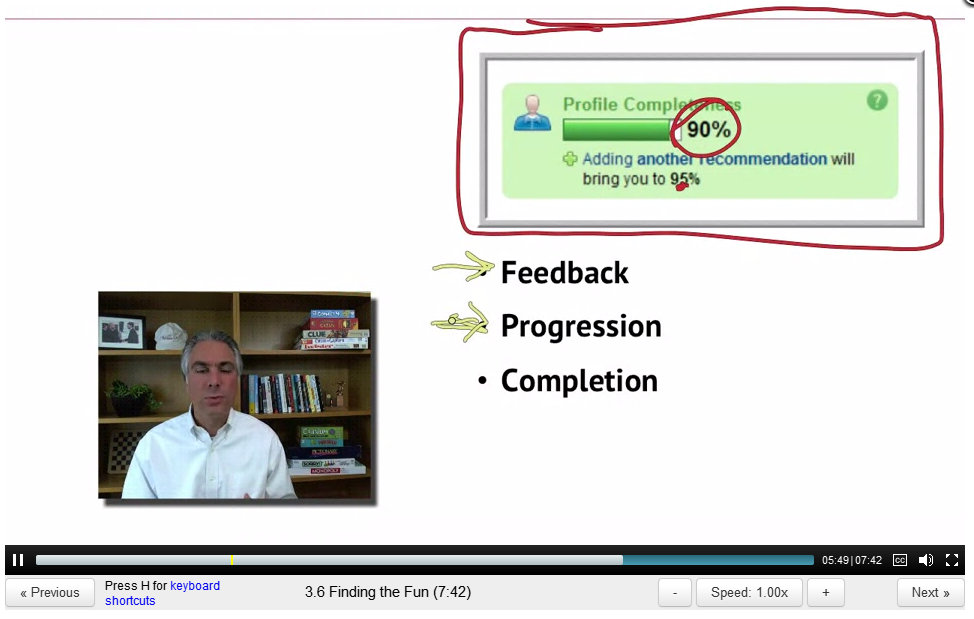
The bottle game looked fun!
One thing we were told, was also to take into consideration situational awareness, not that it’s a huge issue in this case. But for example, if you make a single player mobile app game that requires the sound on or for you to add voice input, people are not likely to want to play that in public.
Play has an aspect of performance in it, so if I imagine I need to take the bottles out, and I’m alone, I might go for the normal one to not draw attention to myself and suddenly become a street-bottle-dance-performer.
A game that emphasizes performance is for example Guitar Hero and Sing Star. Is it gamifying music? Is Guitar Hero just about memorizing a certain sequence and tempo of pressing buttons or is it playing air guitar on an advanced level? Half the fun of those games is the performance, but how to use play-performance is also something to consider.
I also wanted to raise another point with the “What Things are Fun?” list. I get the impression Kevin Werbach is an optimist because he left out a huge chunk of gamer motivation, and SL residents will surely be familiar with it – griefing and ganking.
Richard Bartle’s old gamer typology lists “Killers” as the fourth type.
Quoting Richard Bartle @ http://www.mud.co.uk/richard/hcds.htm:
“Killers are interested in doing things to people, ie. in ACTING on other PLAYERS. Normally, this is not with the consent of these “other players” (even if, objectively, the interference in their play might appear “helpful”), but killers don’t care; they wish only to demonstrate their superiority over fellow humans […]”
PvP and player-competition is common areas for Killers. An older generation MMO such as Ultima Online allowed for more grief-like actions than WoW for example. (Such comparisons raise interesting questions about what is considered griefing and how code and technology comes into it).
As you can imagine, catering to this kind of fun will chase away certain other players, but when designing a game, always take into account how a griefer/cheater might play it.
I don’t actually know much about how griefing, ganking or cheating work in conjunction with gamification, but I saw a presentation by René Glass about Forsquare and cheating and I found the proceedings:
http://uu.academia.edu/Ren%C3%A9Glas/Papers/1198237/Breaking_Reality_Exploring_Pervasive_Cheating_in_Foursquare
ps: Sorry for huge the comment, it was a little overkill(!)
Sorry, it was René Glas! (only one “s”)